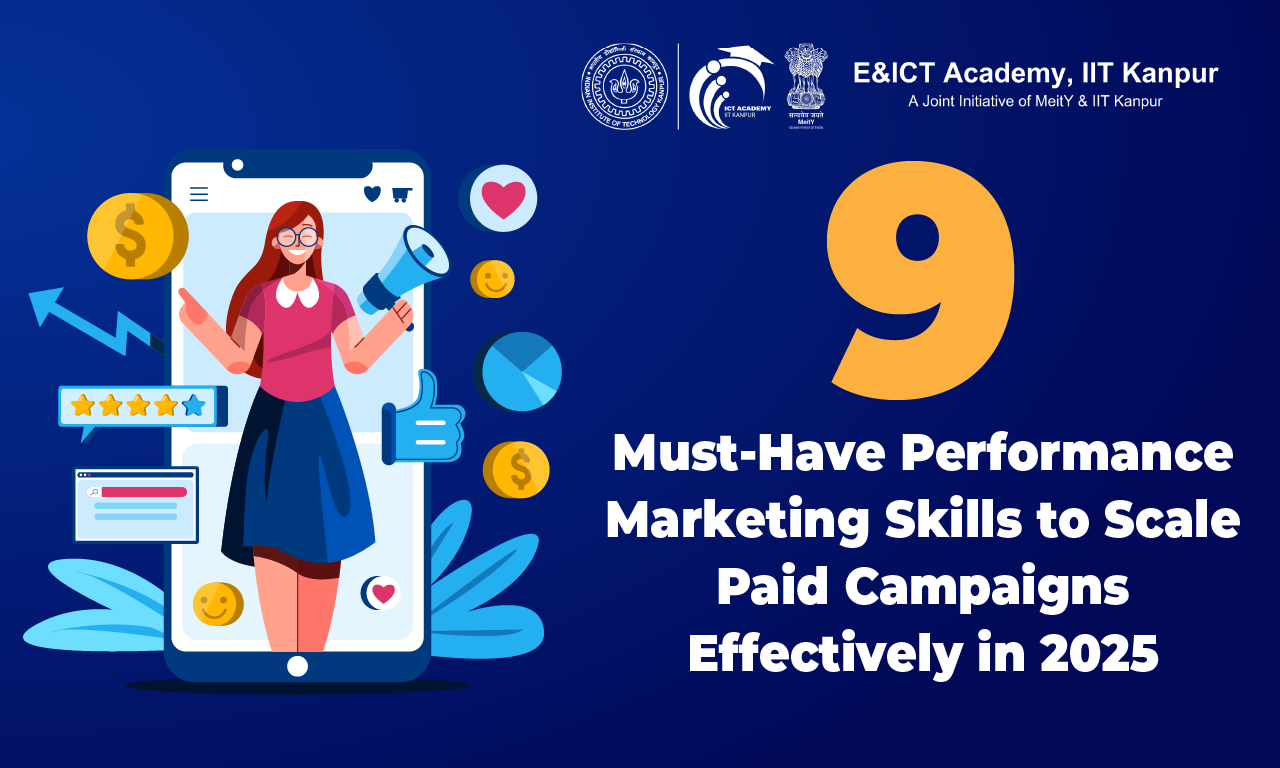9 Must-Have Performance Marketing Skills to Scale Paid Campaigns Effectively in 2025

Performance Marketing Skills: Performance marketing has changed the way companies execute paid campaigns, making decisions based on data crucial. As global digital advertising expenditure is projected to increase by 10.1% in 2025, surpassing $765 billion, competition will heat up. Marketers need to enhance their strategies to improve ad efficiency while reducing expenses.
Beyond simply growing the budget, effective scaling of a campaign requires a thorough approach to audience targeting, increasing conversion rates, and implementing AI and automation to improve performance. Brands that succeed in doing so can increase ROI while maintaining low CPAs.
This article highlights the nine essential abilities that every performance marketer must acquire to expand paid campaigns by 2025.
Must Read: SEO vs PPC: Which One Should You Learn First to Start Your Digital Marketing Career in 2025?
1. Data Analysis and Interpretation
The foundation of effective marketing lies within data as reputable marketers utilize data to restructure their efforts and enhance efficacy. Marketers evaluate engagement by analyzing click-through rates (CTR) for ad impressions while Cost per Click (CPC) tracking ensures efficient budget spending. Together, these metrics help scale campaigns effectively, driving measurable growth.
- CTR: This measures how well an advertisement engages the public.
- CPC: This shows how well the advertisement costs are managed about the advertisement’s effectiveness.
- Return on Advertised Spend (ROAS): This shows how efficiently advertisement expenditures convert to profit returns.
- Customer Acquisition Cost (CAC): This is important in controlling overspending within the budget.
These parameters allow marketers to enhance customer targeting, improve ad creatives, and optimize bidding tactics. Important tools are: Google Analytics (GA4), Looker Studio Meta Business Suite, and cross-channel user interaction, conversion and advertising tracking software.
Must Read: Digital Marketing Scope
2. Audience Targeting and Segmentation
Targeting the appropriate audience is essential for successfully expanding paid campaigns. Generic targeting is ineffective now. Marketers need to accurately segment audiences to secure high engagement and conversions.
To accomplish this, they need to:
- Utilize first-party data to develop precisely focused audience segments.
- Employ AI-based targeting models to anticipate buying patterns.
- Create comprehensive customer profiles to improve advertisement relevancy.
3. Conversion Rate Optimization (CRO)
Expanding campaigns without boosting conversion rates results in unnecessary advertising expenditure. CRO aims to improve the effectiveness of landing pages and ad designs to optimize conversions.
Essential CRO approaches:
- Optimizing Landing Pages: Making sure pages are mobile-friendly, load quickly, and feature engaging CTAs.
- A/B Testing: Trying out various ad designs, titles, and call-to-action (CTA) buttons.
- UX and UI Improvements: Streamlining the customer experience to minimize obstacles.
An effectively optimized campaign guarantees improved conversion rates without drastically raising ad expenditure.
Also Read: High Paying Career in Digital Marketing
4. Mastering AI and Automation in Ads
The use of technology in marketing is growing rapidly thanks to artificial intelligence. AI increases facility and precision while enabling advertisers to scale more. AI-powered techniques help in improving bids, ad placements, and user engagement.
Examples of AI-enabled ad strategies include:
- Automated Bidding: Google and Meta bid on campaigns using AI to help maximize conversions.
- AI-Driven Ad Placements: The AI makes it possible to show ads at places and times that will fetch the most effective results.
- Chatbots and Automation Tools: The use of AI-enabled chatbots will better promote customer engagement for higher-quality leads.
By integrating artificial intelligence solutions into paid campaigns, marketers can maximize returns while scaling properly and minimizing waste.
Must Read: Top Digital Marketing Certification Programs
5. Cross-Channel Marketing Expertise
Clients engage with brands through various interaction points including website visits, social media engagement, email clicks, ad impressions, and in-app actions. An effective performance marketer should execute omnichannel campaigns to ensure a smooth user experience.
Top strategies for cross-channel marketing:
- Combine search, social media, and display advertisements to ensure uniform messaging.
- Monitor customer paths on various platforms utilizing multi-touch attribution models.
- Implement retargeting tactics to reach potential customers who didn’t make a purchase initially.
A well-implemented cross-channel approach enables marketers to increase brand exposure and boost conversion rates on various platforms.
6. Creative Ad Design and Copywriting
Ad creatives drive engagement and conversions. By 2025, performance marketing will rely on high-quality visuals, videos, and commercials. Prioritizing premium creatives enhances brand recall, captures audience interest, and optimizes campaign performance across digital platforms.
Essential components of successful advertising creatives:
- Captivating Visuals: Top-notch pictures, animations, and carousel advertisements draw interest.
- Video and Interactive Ads: Brief videos and augmented reality experiences are sure to boost engagement.
- Engaging Copywriting: Ads should have persuasive headlines and descriptions that compel someone to try the product or service.
Story-driven video ads significantly boost engagement and conversions, making them a powerful tool for performance marketing.
7. Budgeting and Scaling Strategies Budgeting and Scaling Strategies
Proper budget distribution guarantees that campaigns remain profitable even as they grow. Merely raising advertising expenses won’t necessarily produce improved outcomes.
Optimal budgeting techniques:
- Improving advertising expenditure for the best return on investment by concentrating on the top-performing platforms.
- Expand without increasing Cost Per Acquisition (CPA) by improving audience segmentation and bidding strategies.
- Utilize intelligent budget distribution to allocate funds according to advertising performance metrics.
Marketers who excel in budgeting and scaling techniques can expand campaign reach while maintaining control over acquisition costs.
8. Competitor Analysis and Trend Spotting
Understanding market trends and competitor tactics aids companies in improving their strategies. Marketers need to continuously examine how rivals execute their paid advertising efforts.
Strategies for effective competitor analysis:
- Track your competitors’ strategies via their advertisements using Meta Ad Library and SEMrush. Focus on identifying keywords and creatives. This will help you anticipate changes, elevate your approach, and improve ad performance across the board.
- Keep track of algorithm changes from Google, Meta, and TikTok to maintain an advantage.
Marketers who excel in budgeting and scaling techniques can expand campaign reach while maintaining control over acquisition costs.
9. Privacy Compliance and Ethical Advertising
Marketers face a new set of challenges due to an advance shift in data privacy that limits monitoring and emphasises consent: Analytics use shifts from a bottom-up, third-party approach to focusing on first-party resources, requiring higher compliance of targeting techniques, and constant legal monitoring to ensure campaign success
Key privacy factors:
- Knowledge of the GDPR, CCPA, and recent regulations for the prevention of legal issues.
- Cookie-less tracking strategies including first-party data collection and contextual targeting.
Brands that adopt privacy-first marketing by prioritizing transparency, user consent, and first-party data will not only build customer trust but also stay ahead in an evolving regulatory landscape.
Wrapping Up!
Achieving success in 2025 will be heavily reliant on a marketer’s ability to analyze, create, and execute strategies all at the same time. Organizations must embrace the manipulation of data, accurate marketing, audience segregate targeting, and privacy policies to improve marketing performance.
Marketers who take note of changes within the domain and refine the campaigns are bound to enjoy better performance, lower costs, and greater flexibility to respond to needs.
The nature of performance marketing campaigns has shifted dramatically over the years. It is no longer about running an ad now and then. Creativity, ethics, and other strategic elements now define an effective campaign.



